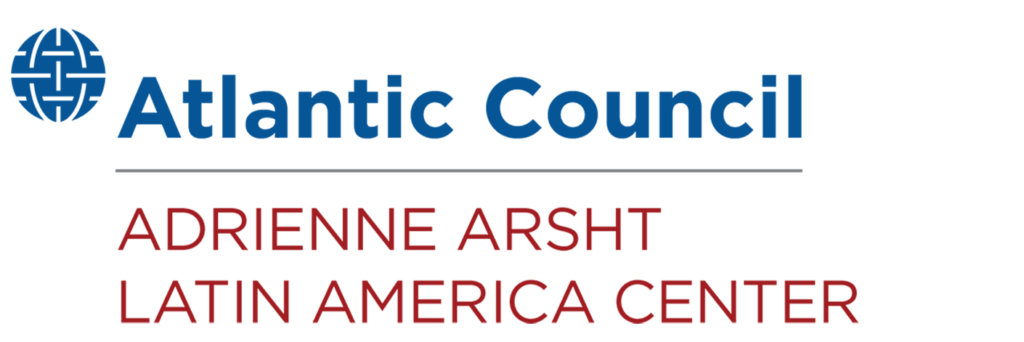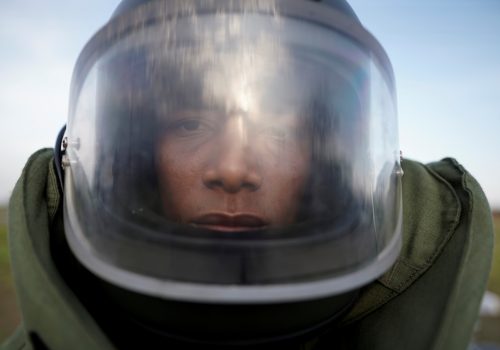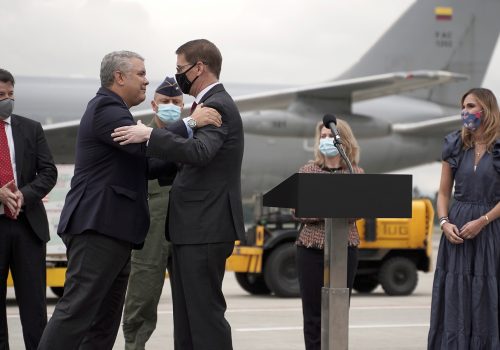Prioritize internally displaced people
At a time when more attention is focused on the desperate plight of Venezuelan refugees and migrants—and indeed, their needs are enormous—it is important not to lose momentum for resolving Colombia’s internal displacement. Despite significant progress in recent years, future improvement will partially depend on ongoing support to implement the historic 2016 peace agreement between the Colombian government and the Revolutionary Armed Forces of Colombia (FARC). This agreement ended a conflict that led to some 220,000 deaths and the internal displacement of more than eight million Colombians.1Colombia: Background and U.S. Relations, Congressional Research Service, Updated December 16, 2021: 1, https://crsreports.congress.gov/product/pdf/R/R43813.
More than five years after the peace agreement, Colombia is still grappling with a long-standing and difficult-to-resolve internally displaced person (IDP) population alongside continuing displacement. The government is also confronting the challenge of responding to a large-scale influx of almost two million Venezuelan refugees while the urgency around Colombian IDPs is dissipating.
Solutions that enable IDPs to go home or begin new lives elsewhere will require continued US support.
Origins of Colombia’s internal displacement
The story of internal displacement in Colombia is rooted in the history of long-standing conflicts with guerrilla groups, such as the FARC, National Liberation Army (ELN), and paramilitary and successor armed groups known as Bandas Criminales or BACRIM. Displacement has been a deliberate strategy pursued by armed groups and the consequence of governmental counterinsurgency efforts. The struggle to control land has been at the center of insurgency campaigns and economic interests linked to the narcotics trade and illegal mining operations.2Although not addressed in this essay, Colombians have also been displaced by disasters. The Internal Displacement Monitoring Center estimates that 64,000 Colombians were newly displaced by disasters in 2020, “Colombia,” Internal Displacement Monitoring Centre, accessed March 15, 2022, https://www.internal-displacement.org/countries/colombia. As in many countries, the response to disaster displacement is carried out by various ministries and agencies.
In the late 1990s, the Colombian government adopted Law 387, which upheld the rights of IDPs and provided assistance and support.3UN High Commissioner for Refugees, Refworld, “Law 387,” https://www.refworld.org/ docid/5a255b374.html, accessed March 1, 2022. This was the first comprehensive legislation on IDPs globally, and since then, Colombia has developed an impressive array of laws and policies intended to support IDPs. Yet, despite laudable innovation and achievements on the policy front, the number of IDPs has continued to increase over the past thirty years.
Displacement has taken various forms in Colombia. In some cases, whole communities have been displaced while some were dislocated individually, known as gota a gota (drop by drop) displacement. Many people have been displaced multiple times. Every province in Colombia has been affected, but it has been especially significant in areas of conflict where state presence is lacking. Afro-Colombian and Indigenous groups have been disproportionately displaced. Almost 90 percent of Colombia’s internal displacement has been from rural to urban areas. Intra-urban displacement has also increased in the past decade, mainly due to turf battles between rival criminal groups.4“From aid to empowerment: Addressing urban displacement in Colombia’s informal settlements,” Internal Displacement Monitoring Centre (2020): 5, https://www.internal-displacement.org/publications/from-aid-to-empowerment-addressing-urban-displacement-in-colombias-informal.
In 2011—five years before the peace agreement—the Victims and Land Restitution Law (Victims Law) recognized IDPs as conflict victims.5Government of Colombia, “2011 Victims’ and Land Restitution Law,” accessed February 22, 2022, https://www.unidadvictimas.gov.co/sites/default/files/documentosbiblioteca/ley-1448-de-2011.pdf. In 2020, the law was extended until 2031. Colombian IDPs, who thought the authorities and public had overlooked their plight, had long sought this. The Victims Law provided compensation and the restitution of land to displaced persons. With US Agency for International Development (USAID) support, the Colombian government set up a Victims Unit to register and compensate victims. The tally of victims in the Victims’ Registry includes deaths, disappearances, and other human rights abuses, but IDPs make up the largest number. According to the Victims Registry, as of April 21, 2022, 9,263,826 people were registered as victims, of whom 89 percent were IDPs. Of those, 81 percent (6,711,922) were eligible for assistance.6Government of Colombia, Unidad de Victimas, accessed February 22, 2022, https://www.unidadvictimas.gov.co/es/registro-unico-de-victimas-ruv/37394. Note these figures are higher than those reported by the Internal Displacement Monitoring Centre and the United Nations. Compensating so many people is complex, and restituting their land is even more so. While the law provides land restitution to IDPs displaced after 1991, the process has been slow due to ongoing conflicts in many areas; most of the displaced have not received any form of government compensation.7Sydney Chloe, Stuck in the Middle: Seeking Durable Solutions to Post-Peace Agreement Colombia, Internal Displacement Monitoring Centre, March 2019: 6, https://www.internal-displacement.org/sites/default/files/publications/documents/201903-colombia-cross-border-report.pdf.
Resolving as key to the 2016 peace agreement
The 2016 peace accord sought to address the underlying causes of the conflict, support victims’ rights, and assure transitional justice and reconciliation. IDPs participated in the consultative processes leading up to the agreement, an unprecedented process globally, largely due to IDPs organizing themselves and strong support from civil society organizations. The resulting peace agreement reflects their engagement because land reform—and returning land to IDPs or compensating them—is central to the accord.8“Colombia’s Peace Process: The Moment of Truth,” The Economist, August 30, 2014, https://www.economist.com/the-americas/2014/08/30/the-moment-of-truth. The peace agreement, complementing the 2011 Victims law, allowed for compensating victims and redistributing assets obtained by the FARC. Between August 2018 and September 2021, some $735 million in individual compensation was paid.9Data compiled from Colombian government sources and reported in Colombia: Background and U.S. Relations, Congressional Research Service: 24. However, implementing the land pro- visions of the agreement has lagged behind executing other components of the peace agreement.10Five Years of Peace Agreement Implementation in Colombia: Achievements, Challenges and Opportunities to Increase Implementation Levels: December 2016-October 2021, University of Notre Dame (2021), https://curate.nd.edu/downloads/und:5d86nz8373p.
Unfortunately, the peace agreement did not mean the end of the conflict—or displacement. Since 2016, more than 800,000 people have been displaced—and the UN projects an increase in 2022.11Plan de Respuesta Humanitaria: Colombia, UN Office for the Coordination of Humanitarian Affairs (OCHA), February 2022, 11, https://reliefweb.int/sites/reliefweb.int/files/resources/colombia_ hrp_2022_es.pdf. In Medellín, criminal and gang violence is estimated to force 5,000 to 15,000 people from their communities every year.12“Colombia,” Internal Displacement Monitoring Centre, accessed February 28, 2022, https://www.internal-displacement.org/countries/colombia. The ELN, BACRIM, and other groups filled the vacuum left by the FARC when they demobilized and are now the main actors driving displacement. The continuing violence means that even when IDPs are authorized to reclaim their land, security issues often prevent them from doing so. Moreover, Colombia is deeply affected by landmines, which force people from their land and impede their return. And in addition to displacement, there are growing numbers of people experiencing “forced confinement,” in which armed groups prohibit individuals from leaving their communities in search of safety. The UN reports that in 2021, there were 66,000 people forcibly confined, an increase of 77 percent since 2020.13Plan de Respuesta Humanitaria: Colombia, OCHA, 17.
In addition to continuing violence-driven displacement and forced confinement, there have been alarming attacks on social leaders and human rights defenders, including IDPs and their advocates, reflecting the always contentious issues around land. Hundreds of leaders have been killed since 2020.14Adam Isacson, A Long Way to Go: Implementing Colombia’s Peace Accord after Five Years, Washington Office on Latin America, November 23, 2021, https://www.wola.org/analysis/a-long-way-to-go- implementing-colombias-peace-accord-after-five-years/.
With solutions to displacement taking far longer than anticipated, Colombian IDPs continue to face insecurity, stigma, and poverty. They often live in informal settlements that lack adequate housing, services, and infra- structure and experience high levels of violence due to criminal and gang activity. In a positive move, the Colombian government has taken steps since the 2000s to legalize these informal settlements, enabling IDPs to access state support for housing and other social services.15US Agency for International Development, Country Profile: Colombia: Property Rights and Resource Governance, 2017, https://www.land-links.org/wp-content/uploads/2017/01/USAID_Land_Tenure_Colombia_Profile_Revised_December-2017.pdf.
The United States has worked for many years with the Colombian government, UN agencies, and civil society groups to support IDPs and find solutions.16For an overview of US government humanitarian contributions to Colombia, see ColombiaAssistanceOverview, US Agency for International Development, Bureau for Humanitarian Assistance, August 2021, https://www.usaid.gov/sites/default/files/documents/USAID-BHA_Colombia_Assistance_Overview_-_August_2021.pdf. The US Department of State’s Bureau for Population, Refugees, and Migration provided substantial funds for humanitarian assistance for IDPs, which has now been taken on by USAID’s Bureau for Humanitarian Assistance, focusing on resilience and livelihoods in conflict-affected areas.17Colombia Assistance Overview, USAID, Bureau of Humanitarian Assistance. USAID’s CountryDevelopmentCooperationStrategy2020-2025focuses on vulnerable groups, including IDPs, and emphasizes the importance of restoring trust in government and reconciliation—factors essential for creating an environment where IDPs can return to their land.18USAID, Colombia Country Development Cooperation Strategy, July 17, 2020-July 17, 2025, accessed February 25, 2022, https://www.usaid.gov/sites/default/files/documents/Colombia_CDCS_Narrative_Public-Oc7-2020.pdf. This balance between supporting humanitarian aid for the newly displaced and investing in longer-term structural changes has been essential and should continue.
Finding solutions
Finding lasting solutions for Colombia’s eight million IDPs is a challenging and complicated process, particularly as many have been dis- placed for years or even decades. But it is key to Colombia’s future security and development. When 16 percent of Colombia’s population remains displaced within their borders, and tens of thousands are uprooted every year, it is hard to talk of post-conflict stabilization or reconciliation. Ending internal displacement means making time-consuming decisions on restitution and compensation and enabling IDPs who cannot return to rebuild their lives elsewhere.
Recommendations for US-Colombian future collaborations:
- The United States should continue to support Colombia’s efforts to implement the 2016 peace agreement, including provisions related to resolving displacement. In particular, US support for land reform in rural areas and formalizing urban settlements19USAID, Country Profile: Colombia: Property Rights and Resource Governance, 2017, https://www.land-links.org/wp-content/uploads/2017/01/USAID_Land_Tenure_Colombia_Profile_Revised_ December-2017.pdf. is crucial and offers opportunities for private sector engagement. US support for Colombian IDPs has been consistent and essential over the years and must be sustained—even as new displacement crises in other countries strain humanitarian funding. The United States can also do more to highlight the continuing needs of IDPs in its diplomatic and public outreach activities, such as in multilateral meetings and public statements on Colombia and humanitarian issues.
- The United States should increase its efforts to protect leaders of IDP associations and human rights defenders and urge Colombia to do more to end impunity for these attacks.20Some concrete suggestions for doing so were raised by the Washington Office for Latin America in How the Biden-Harris administration can protect and support social leaders in Colombia, 2021, https://reliefweb.int/sites/reliefweb.int/files/resources/Policy%20recommendations%20-%20How%20 the%20the%20Biden-Harris%20administration%20can%20protect%20and%20support%20 social%20leaders%20in%20Colombia.pdf. Civil society groups play a vital role in denouncing human rights violations and monitoring governmental progress in resolving displacement and implementing the peace agreement. The United States should make it clear to the Colombian government that this is a high priority and monitor the effectiveness of governmental efforts to protect social leaders through Colombia’s National Protection Unit, for example, which provides protective measures, such as bodyguards and protective gear.21Colombia: Background and U.S. Relations, Congressional Research Service.
- Colombia’s Truth Commission (Comisión para el Esclarece- miento de la Verdad, la Convivencia y a la No Repetición)22For more on the work of the Truth Commission, see Comisión de la Verdad website, accessed March 15, 2022, https://comisiondelaverdad.co/. is expected to present its final report by mid-2022,23Christina Préfontaine, “2022 – un año para la verdad y la reconciliación,” El Espectador, January 31, 2022, https://www.elespectador.com/colombia-20/analistas/2022-un-ano-para-la-verdad-y-la-reconciliacion/. offering an opportunity to assess Colombia’s progress with transitional justice and redouble US government efforts to support lasting solutions. Following this publication’s release, USAID could organize a roundtable with representatives from government, civil society, IDPs, and academia to assess progress and identify steps to speed up the lengthy process of resolving displacement.
Colombia’s IDPs have been waiting for a long time to end their displacement. The Colombian government has taken impressive action to ensure that mechanisms are in place to allow them to recover their land and return to their communities. But finding solutions for almost seven million IDPs requires renewed commitment from the Colombian and US governments and the international community.
Related Allies essays
A roadmap for a new type of engagement
This moment opens the door for a reimagined US partnership with Colombia based on a shared vision for a more prosperous, inclusive, and sustainable future.
Related program

The Adrienne Arsht Latin America Center broadens understanding of regional transformations and delivers constructive, results-oriented solutions to inform how the public and private sectors can advance hemispheric prosperity.
Image: Central American migrants stood in line before entering a temporary shelter in Deming, New Mexico, on May 16 after they illegally crossed the border between Mexico and the United States. (Reuters/Jose Luis Gonzalez)


